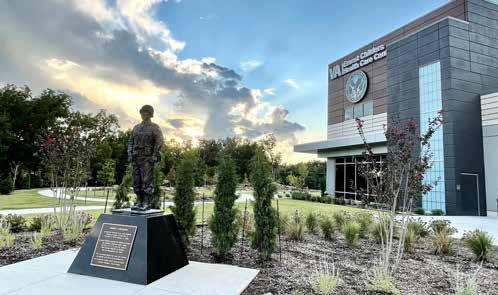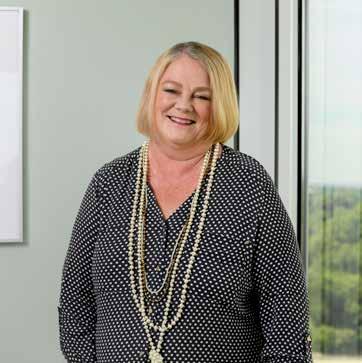
8 minute read
Arlington National Cemetery Our Nation's Most Hallowed Ground
Fall foliage in Section 21 of Arlington National Cemetery
Photo by U.S. Army, Elizabeth Fraser / Arlington National Cemetery / released
ARLINGTON NATIONAL CEMETERY
Our Nation’s Most Hallowed Ground
The United States established its first national cemeteries for fallen troops during the Civil War. Today nearly 4.9 million people, including veterans of every conflict starting with the Revolutionary War, are honored by burial in national cemeteries.
BY STEVE CLEM
Arlington National Cemetery is the nation’s most hallowed ground. Across the Potomac River from Washington, D.C., its 639 acres of rolling hills and ancient trees are the final resting place for 400,000 men and women, including veterans, two American presidents and various other dignitaries.
Each year, nearly three million visitors pass through their gates to honor our nation’s war heroes, witness the changing of the guard at the Tomb of the Unknown Soldier, and pause at the gravesite of President John F. Kennedy. Other prominent soldiers and civilians buried at Arlington include General John J. Pershing and Supreme Court Justice Thurgood Marshall, as well as the cremated remains of the seven astronauts from the Space Shuttle Challenger. Although Arlington National Cemetery was founded during the Civil War in 1864, it contains graves from every American war. Its history is ongoing. About 150 funerals are held each week. Qualifications for an Arlington burial are the most stringent of the U.S. National Cemeteries, with eligibility determined at the time of need.
For more breathtaking images of Arlington National Cemetery visit their profile on Flickr.
www.flickr.com/photos/ arlingtonnatl/albums
TOMB OF THE UNKNOWN SOLDIER
This month is the Tomb of the Unknown Soldier Centennial Commemoration. At the end of World War I, there were many unidentified American soldiers overseas. A single, imposing, whitemarble tomb with one unknown soldier, was a way to honor all of America’s unidentified heroes. Dedicated on November 11th, 1921, guard duty was established during daylight hours in 1926. Then, in 1937, the guards were expanded around the clock. Over the years, an expansive white marble sarcophagus replaced the solitary tomb, and more unknown soldiers were interred from World War II and the Korean War.
ARLINGTON NATIONAL CEMETERY,
continued on page 34.
Fort Gibson National Cemetery
Providing a Pristine Resting Place for Veterans
BY STEVE CLEM
Nestled into the rolling hills of Green Country, are monuments to 28,000 American heroes.
Fort Gibson National Cemetery, 50 miles east of Tulsa near the town of Fort Gibson, Oklahoma, is the final resting place for men and women who have served their country with honor.
Looking out onto the gently cascading landscape, one is awestruck by the rows of perfectly aligned markers and the sacrifices they represent. It is a serene setting with immaculate grounds. The gravestones seem immune to the ravages of the elements that typically degrade them over time.
“Keeping the markers in pristine condition is a benefit of burial here,”said Cemetery Director David Van Meter. Van Meter oversees both of the Sooner State’s national cemeteries, Fort Gibson and Fort Sill in southwestern Oklahoma.
Encompassing 48 acres with room for expansion, the cemetery offers both burial and inurnment services. Many veterans qualify for allowances for those costs. But unlike a regular cemetery, plots aren’t reserved in advance. "At the time of need, the family member or next of kin contacts our scheduling office, and we begin the process,” Van Meter explained. “Typically, funeral homes will work with us to accomplish this.”

This hallowed ground was once part of the country's westernmost military outpost. Fort Gibson, Indian Territory was established in 1824, more than a half-century before the rest of the land that later became Oklahoma was settled.
During the fort’s 60-year existence, it was the western terminus for the Cherokees during the Trail of Tears. After the Civil War, seven acres of the fort’s footprint were designated as a national cemetery.

Headstones at Fort Gibson National Cemetery
Photo courtesy of Steve Clem
Living LIFE to the fullest.
Health Insurance Questions?
Our local enrollment specialists are here to help! Call 888-346-9636 or visit BlueNearYouOK.com for more info.
Blue Cross and Blue Shield of Oklahoma, a Division of Health Care Service Corporation, a Mutual Legal Reserve Company, an Independent Licensee of the Blue Cross and Blue Shield Association 611913.0921

An Army Full Honors Wreath-Laying Ceremony is held at the Tomb of the Unknown Soldier in honor of the 245th birthday of the U.S. Army at Arlington National Cemetery, Arlington, Virginia on June 14, 2020.
Photo by U.S. Army, Elizabeth Fraser / Arlington National Cemetery / released Section 60 is shown following a snow storm at Arlington National Cemetery in February 2021.

Photo by U.S. Army, Elizabeth Fraser / Arlington National Cemetery / released
ARLINGTON NATIONAL CEMETERY,
continued from page 32.

A sentinel from the 3rd U.S. Infantry Regiment (The Old Guard) guards the Tomb of the Unknown Soldier at Arlington National Cemetery.
Photo by U.S. Army, Elizabeth Fraser / Arlington National Cemetery / released

Jack Eaton (left) was the oldest living Tomb Guard Sentinel at 100 years old when he revisited the Tomb of the Unknown Soldier in October of 2019.
Photo by U.S. Army, Elizabeth Fraser / Arlington National Cemetery / released
The soldiers who guard the sacred tomb undergo an intensive selection and training process. Their every step and gesture is precise and has meaning. The number 21 repeats in their movements: 21 steps down and 21 steps back; facing east for 21 seconds, then north for 21 seconds. This symbolizes the highest military honor: the 21-gun salute.
It may come as a surprise that only two American presidents, William Howard Taft and John F. Kennedy, are buried at Arlington. Taft was interred in 1930. Traditionally, U.S. presidents have been buried in their hometowns. When President Kennedy was assassinated in 1963, many assumed he would be buried in his hometown of Brookline, Massachusetts. However, his widow, First Lady Jacqueline Kennedy, insisted that her husband be accessible to the public, so he was buried at Arlington. During the funeral, broadcast around the world on November 25, 1963, Mrs. Kennedy lit an eternal flame at the head of her husband’s grave. At first, Kennedy was interred between his and Mrs. Kennedy’s two infant children, Patrick and Arabella, whose graves were moved to Arlington from Massachusetts. One year before Caroline’s birth in 1957, the couple’s first daughter, not officially named but later referred to as Arabella, was stillborn. Patrick Bouvier Kennedy, the youngest of the couple’s children, was born three weeks premature in 1963 and passed from respiratory distress syndrome shortly after birth.
The original plot was surrounded by a white picket fence. In the first three years after Kennedy’s death, more than 16 million people had visited the gravesite. Due to the throng of visitors, in 1967, the Kennedy graves were moved to an area that could better accommodate the crowds. In the years since, Jacqueline Kennedy, Robert F. Kennedy and Edward M. Kennedy have also been interred there.
The cemetery’s expansive, manicured grounds include Arlington House, once the residence of Confederate General Robert E. Lee, a 100-year-old amphitheater, and dozens of other memorials, statues and other artwork, many from notable artists of past centuries.
Due to its proximity to Washington, D.C., Arlington cemetery is easy to access. From D.C., there are a myriad of transportation options, countless tours and tour companies to take you. You can also drive or walk there yourself. There is no right or wrong way to see this national shrine.
Visiting Arlington National Cemetery is an experience that can provide an increased understanding of who we are as Americans – how we got here – and of the sacrifices made.
Announcing LIFE Senior Services’ New Program

For More Information Call LIFE’s SeniorLine

(918) 664-9000
www.LIFEseniorservices.org
Club LIFE welcomes individuals diagnosed with early memory loss caused by Alzheimer’s disease or other related disorders. Club LIFE is designed to enhance memory, improve physical strength and balance, stimulate brain function and provide social support.
In addition, Club LIFE supports caregivers through personal consultation, education about early memory loss and support groups.
FOLLOW US ON
FREE Subscription to LIFE’s Vintage Newsmagazine
Get Oklahoma’s award-winning publication designed especially for today’s 50-plus population delivered to your home each month.
ACT NOW 3 WAYS TO SUBSCRIBE:
ONLINE
Visit www.LIFEseniorservices.org and click the education and resources tab.
BY MAIL
Complete and mail in the attached subscription form to the listed address.
BY PHONE
Call (918) 664-9000, ext. 1207.
q
Yes, I want a free subscription to LIFE's Vintage Newsmagazine.
Name _______________________________________________________________________________________
Address ______________________________________________________________________________________
City/State/ZIP ______________________________________________________________________________
CUT OUT AND MAIL TO:
LIFE Senior Services 5330 E. 31st St., Ste. 800 Tulsa, OK 74135
Build Strong Bones Improve Balance Increase Strength Decrease Joint Pain Improve Posture
We’re not a Gym—Learn more “OsteoStrong 101” Lecture
Tue 6pm or Fri Noon
Call to Reserve Your Seat
5940 S. Lewis Ave Tulsa, OK 74105 918-528-3828 www.OsteoStrong.me
Be Safe Be Well Be Osteostrong

Searching for a new apartment?
Small Pets Welcome
Sheridan Terrace
Independent Senior Living
• All bills paid • Emergency call system • Inside hallways • Small pets welcome • Quiet location
• Subsidy available
Sheridan Terrace does not discriminate against individuals with handicaps.
(918) 835-7072
1937 S. 68th E. Ave. | Tulsa, OK
(NE of 21st and Sheridan)
Pick up the PACE
LIFE PACE, a Program of All-Inclusive Care for the Elderly, is a senior health plan that provides quality medical, social, and home care services to Tulsa Area seniors who prefer to remain living at home, but need support to do so safely. For those that qualify for DHS waiver, PACE services may be available at NO COST. Medicare Open Enrollment ends December 7, so now may be the time to consider additional support for you or your loved ones.









